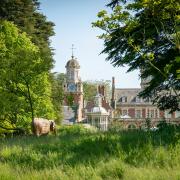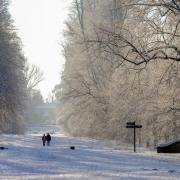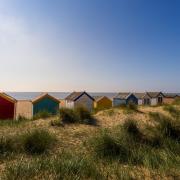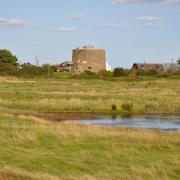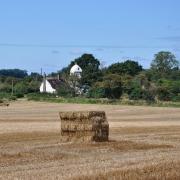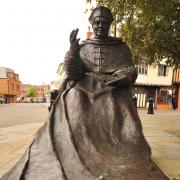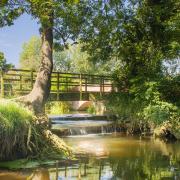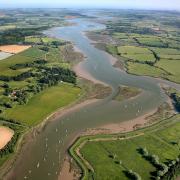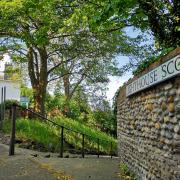An uplifting Brett Valley walk through an ancient area of mysteries and miracles in search of Suffolk’s ‘Camino de Kersey’ | Words and pictures: Lindsay Want

Walsingham, Bury St Edmunds, Canterbury… Kersey. Most surprisingly, they all have one thing in common.
Turn back the clock 600 years or more and as you climb towards St Mary’s church in Kersey you’d probably be in the company of pilgrims. Push open the south porch door and from the ogee-topped north aisle niche there would be glints of gold from a highly venerated shrine.
On Church Hill today, original road signs from the early days of motoring point to how Kersey has long been popular with visitors.

In early medieval times, it was already on the tourism circuit, long before Pope Pius II officially recognised ‘St Mary of Piety Kersey’ as a place of ‘infinite miracles’ in 1464.
The great niche is still there, but we can only imagine the miraculous goings on – history, the Reformation and local Puritanical fervour have secreted them conveniently away, together with the saintly trappings.
Where those early pilgrims journeyed from, the separate ways they went or paths they trod are all part of the mystery. But set out along Kersey Brook, climb its silent steep valley sides and somehow the ancient landscape has a way of helping you find what you’re looking for.

A path by a hotch-potch of pink cottages near Kersey’s greenless Green points over stiles, past hedgerow feeding-grounds of rosy-breasted bullfinches. A procession of telegraph poles leads through sloping pastures speckled gold with Rough Hawkbit.
On the wide horizon, the lines of poplars and occasional oaks obscure the castle earthworks of Lindsey’s motte and bailey adulterine castle. Dating from King Stephen’s reign, the castle may be as elusive as it was short-lived, but you know it’s there.
Did early travellers call at its gates before it was abandoned? Maybe Kersey’s medieval pilgrims stopped by the bailey pond for refreshment?

Nearby ‘unofficial’ castles like Milden or Offton were swiftly stamped out, yet Lindsey’s earthworks are not the only miraculous survival in this neck of the woods.
There’s no cool breath of silence in the valley like the one you feel inside the ancient walls of St James’ Chapel. Simpler than isolated Iken or Isleham near Freckenham, the space between flint-cobbled walls, beneath the heavy hull of timbers is undeniably awesome.
Let the door swing to and blades of light from deep-set lancet windows slice through the darkness. In 1240, noble local landowner, Nesta de Cockfield, had the bright idea of introducing ‘Lindsey Tithes’ to pay for its lighting. Was it the castle’s chapel? A prayer-stop for pilgrims?

A chantry chapel until 1547, religious politics then farmed it out as a barn – its fate for centuries, until gifted to the nation in 1930.
The 14th century porch at towerless St Peter’s is the perfect place to sit a while. It’s easy to imagine weary folk through the ages taking a perch here.
Perhaps some left their mark too. Inside, there’s early graffiti of waterfowl and weird ceremonial crosses, even bishops in horned mitres – all the rage apparently in the 12th century.

High on the plateau, Kersey’s hilltop church on the horizon beckons. Pass by woodland encircled by tall evergreens, the site of Nesta’s Augustinian priory, dissolved even before the Pope gave Kersey his special blessing.
But no doubt travellers stopping near the gates to gaze joyfully at their long-awaited destination were shown hospitality.
Back in the village, block out the call of The Bell Inn and keep walking. Climb back up to St Mary’s. Look inside at the smooth rise-and-falls of its arcading worthy of a cathedral, or the familiar greens and yellow dots of gold on its exquisite medieval rood-screen frieze.
It’s amazing how even the shortest mindful journey can make us see things differently. Kersey is still a place of miracles.
The route
1) Start at Kersey Church (IP7 6EF). Walk down Church Hill.
2) Before the ford, turn left. Bear immediately right through wooden gate, down track to a stile. Continue on footpath to reach row of telegraph poles.
3) Follow footpath sign over fence-crossing and diagonally left uphill, in line with telegraph poles, to stile. In next meadow, keep with poles to stile by hedge.
4) Cross stile, go right along field edge. At junction of tracks, follow signs left uphill, along field edge. Go through hedge gap to reach lane before Bridge’s Farm.
5) Cross road. Signed footpath leads straight ahead to gate. Continue diagonally downhill across meadow to gate by footbridge. Path leads down over meadow, into woodland tunnel via footbridge to road. Turn left.
6) St James Chapel (left) is accessed through wooden gate (Free entry 10am – 4pm). Continue along road.
7) At Rose Green crossroads, turn right.
8) At junction by Lindsey village hall turn right to St Peter’s Church. Continue to next T-junction. Turn left to pass Lindsay Hall.
9) Where road bears sharp left, take signed footpath straight ahead, across the common.
10) Path leads through woodland. Keep to right fork in paths, emerging into a field. Note a woodland diagonally right, Kersey church in the distance behind it. Path goes straight ahead, then right to meet the wood. Bear left as it edges the wood (on right). At corner of wood, bear left, across field.
11) Reaching woodland, turn right to pass two areas of woodland encircled by tall evergreens (site of old priory).
12) At road by Priory Farm, turn left. At Priory Hill Cottage, take footpath right to top of The Street. Descend to the ford (2), climb to St Mary’s (1).
Compass Points
Distance: 6.5 miles/ 10.5 kms
Time: 3 hours
Start: Kersey - Church Hill (IP7 6EF).
Getting there/back: suffolkonboard.com
Parking: Kersey - The Street/Church Hill
Access: Field-edge, cross-field and woodland footpaths; some tarmac roads. Stiles. Steps.
Big Map to hand: OS Explorer 196
Ts & Ps: Pub in Kersey




